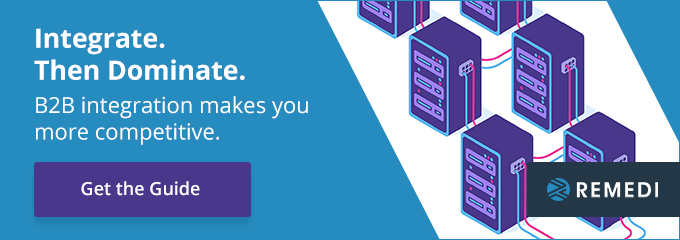
Today’s business environment is more complex and more uncertain than ever before. You’re no longer doing business with partners in the same city or state – they might not even be in the same country as you. To stay competitive, you need modern integration solutions.
This post will explore what a modern integration environment is and why you need it today to survive and grow. See some of our recent data transformation success stories.
What Is a Modern Integration Environment?
A modern integration environment has five capabilities
- It's future-proof
- It automates processes
- It's highly scalable and expandable
- It integrates a variety of data
- It integrates with legacy technology
Modern Integration Solutions Are Future-Proof
A modern integration environment is flexible. It won't limit you if you want to integrate with emerging technology in the future.
Modern Integration Solutions Automate Processes
Manual processes lead to costly errors. Moreover, they waste employees' time. On the other hand, a modern integration environment automates processes for greater accuracy, efficiency, and cost savings.
Automation can either be scheduled or event-based. "Event-based" means an event triggers an automated process – for example if a customer submits a purchase order, the order fulfillment system receives an automatic notification.
Modern Integration Solutions Are Highly Scalable and Expandable
As your business grows, so too must your integration environment. It should do two things: scale and expand.
When we talk about "expanding," we mean that you should be able to use features you weren't using previously. "Scalability" means that it's easy to add new users. Moreover, it's simple to add new features and integrations when necessary.
Modern Integration Solutions Integrate with a Variety of Data
At one point, the only data you could access was that which was already inside your organization (such as from ERPs). That's no longer the case – there's so much information out there, internal and external. Also, data is now structured (meaning it's machine-readable) and unstructured (machines can't read this information; examples include videos and audio). An additional challenge arises when you consider the size of data and its disparate locations.
That's why modern integration solutions must handle a variety of data: structured, unstructured, inside the company, outside of the company, and in many sizes. There's so much valuable information out there that can affect your company, and you don't want to miss an opportunity.
Modern Integration Solutions Must Integrate with Legacy Technologies
It might sound like a strange capability for a modern integration environment to have, but it's crucial for it to integrate with legacy technologies.
Many companies still use legacy systems every day, and these systems store vital information. If you can't access that information, you don't have the complete picture of what's going on in your business. As a result, you could make the wrong choices.
APIs: the Unsung Hero of Modern Integration Solutions
One of the technologies enabling modern integration solutions is APIs. API stands for application programming interfaces.
APIs act as a wall socket for applications; they allow an application to consume information from a data source, much like an electrical outlet that enables a device to consume electricity. We'll illustrate with an example: an API could connect to an ERP system, so you could access that information on a mobile device.
The Benefits of APIs
Before we talk about why you need a modern integration environment to ensure your business's growth and survival, let's look at APIs' benefits, as they play a significant role in these modern integration environments.
APIs have several benefits:
- They allow for instant information transfer
- They connect to more information sources than an EDI system alone
- They overcome the deficiencies of other architectures
Why Do You Need a Modern Integration Environment for Business Survival and Growth?
There are several reasons you need a modern integration environment to ensure your business's survival and growth:
- You need real-time information to survive in an uncertain business environment
- Your customers want the capabilities that a modern integration environment offers, such as digital B2B connectivity
- You can cut down onboarding time for greater efficiency
- You can integrate new streams of information for increased supply chain visibility
- You can pay digitally and accept digital payments
You Need Real-Time Information to Survive in an Uncertain Business Environment
Today, access to real-time information has become a competitive advantage. If you don't know what's going on with your supply chain partners right now, you could be at risk for shipment delays, which cost you time and reputational damage.
With a traditional EDI system, you can process information in large batches, yet you can't access it in real-time. So, if a customer contacted you asking for a status update on his order, you can't give him that information. Conversely, modern integration solutions use APIs and other streams of information (more on that later) to provide you with greater visibility into your supply chain than ever before.

We’ll illustrate with an example about the value of real-time information. At the beginning of 2020, a global pandemic swept across the world. It shut down factories in China, which had a devastating impact on global supply chains. Companies that had access to real-time information could mitigate the impact of factory shutdowns; their competitors without such access did not farewell.
Customers Want Business Connectivity
Digital B2B connectivity refers to the ability a business has to sell its products online through such venues as digital marketplaces (like Amazon Vendor Central or Amazon Seller Central) or e-procurement hubs (like SAP Ariba). More and more companies want to buy B2B products and services through digital marketplaces and e-procurement hubs.
In 2019, digital B2B sales grew from$8.1 trillion to $9 trillion – an 11% increase. It’s easy to understand why B2B buyers find digital B2B connectivity so attractive; it’s convenient, and younger B2B buyers feel comfortable doing it because they buy goods and services online in their personal lives.
“In 2019, digital B2B sales grew from $8.1 trillion to $9 trillion.”
A modern integration environment enables B2B connectivity. It utilizes APIs to hook into your EDI system, so customers can place orders and they’re put through your order fulfillment system.
Cut Down on Onboarding Time for Greater Efficiency
At many large firms, it can take between three to six months to onboard supply chain partners. It’s such a lengthy process because it adds multiple layers of risk, and it involves several layers of internal functions (including but not limited to procurement, legal, and compliance). You must mitigate those risks, too.
Yet, you have no guarantee during that lengthy onboarding process that the partner won’t experience a crisis like a factory shutdown. If that were to happen, you might need to find another supply chain partner and start the entire process once more.
“At many large firms, onboarding partners can take up to six months.”
A modern integration environment speeds up the onboarding process. It uses APIs to onboard partners in bulk or one by one. Additionally, such integration environments give partners self-service functionality, so they can input their own information.
With modern integration solutions, the partner onboarding process becomes faster without creating more risk for either partner. Faster onboarding means customers can order sooner, and supply chain delays don’t threaten business continuity.
Integrate New Streams of Information for Increased Supply Chain Visibility
There’s more information inside and outside of the enterprise than ever before. Sensors can tell us what the temperature is inside a shipping container. At the same time, blockchain shows us all partners in the supply chain involved in a transaction. This information gives us increased visibility into the supply chain so we can make better decisions.
However, if you can’t harness these information streams, you can’t make better decisions. Traditional EDI systems can’t connect to information sources such as blockchain, social media, IoT devices, or mobile devices. Modern integration solutions, on the other hand, can.
“New information streams give us greater supply chain visibility.”
A modern integration environment can integrate these new information streams into your current integration solutions, so you have a broader picture of what’s going on. You can respond quickly to supply chain disruptions and ensure business continuity.
Accept and Submit Digital Payments
Think about how long it takes to get paid by customers. Their accounting department has to cut a check, but that check first has to be approved. Let’s not forget about the amount of time it takes for the check to go through the mail and arrive in your mailbox (if it doesn’t get lost along the way).
Digital payments, in contrast, go directly to the company. They’re fast and straightforward. Without a modern integration environment, though, you can’t accept or submit digital payments.
“Modern integration environments power digital payments.”
Accepting and submitting digital payments makes it easier for trading partners to do business with you. It also shortens the order cycle, meaning you get paid faster.
Ensure the Growth and Survival of Your Business with a Modern Integration Environment
A modern integration environment ensures your business will be prepared to meet the challenges of today and tomorrow. Integrate. Then Dominate.




